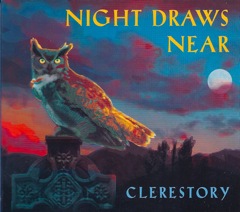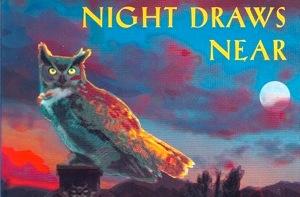
The nine men of Clerestory have taken a daring step. For their first “studio-recorded” CD, laid down in the sanctuary of Berkeley’s Unitarian Universalist Church, they perform music inspired by the three closely aligned celebrations of Halloween, All Soul’s Day, and El día de los muertos. A total of 22 choral selections that explore (to use Clerestory’s own language) “life, death and mysticism” by delving into “the spectrum of emotions elicited by the transition from life into death” may not seem like the ideal stocking stuffer, yet the quality of both singing and composition go a long way toward transcending the gloom.
Although no one knew it at the time the CD was envisioned and recorded, it ended up having unwanted resonance with real events. On August 12, 2010, three weeks after the recording sessions in the third week of July, Clerestory founder Jesse Antin and his wife witnessed the birth of their daughter Margaret. She was stillborn. The men of Clerestory, who did much of the editing and mixing as their founder mourned, have dedicated the CD to Margaret’s memory.
Listen To The Music
Suite de Lorca: Cancion de Jinete
Epitaph on a Dormouse
The exceptional sincerity and beauty of the singing elevate the performances. Take, for example, contemporary composer John Tavener’s Funeral Ikos (1981). Embracing the first two monophonic lines with the unadorned piety of Gregorian monks, Clerestory sings as of one voice and heart. When the voices do part, as in the repeated recitation of “Alleluia!,” the purity of the high voices, plus the quiet solemnity of those on the bottom, is exceptional. The second repeat of the triple “Alleluia!” evolves as if from a deeply felt sigh.
The four songs of Einojuhani Rautavaara’s Lorca Suite, written in 1973, highlight the special qualities the men bring to their music. The hollowness of the deep bass intoning in “Canción de jinete” (The rider’s song) could not be more appropriate. Especially when the work is sung with such unfussy precision, the intimacy created by an ensemble of nine mostly former members of Chanticleer at times makes a deeper impact than the larger forces of the currently 12-member mother ensemble. Never do these men sound like graduates of Miss Jones’ Finishing School, which is how Chanticleer can occasionally come across. Recording/mastering engineer David v.R. Bowles of Swineshead Production deserves ample credit for conveying the group’s inward intimacy while capturing just the right amount of church resonance.
Despite the occasional mild flashes of humor, such as Benjamin Cooke’s 18th-century, sin-laced Epitaph on a Dormouse, the subject matter is hardly cheery. Not everyone will be drawn to playing the CD straight through without pause. But, given such exceptional composers, who include Tomás Luis de Victoria, Gerald Finzi, Peter Warlock, Ralph Vaughan Williams, and John Musto, the CD is highly recommended.
The printed notes included are minimal, but the 29-page, full-color online booklet, designed by Tim Warner of a writing and design company coincidentally called Clerestory, is exceptional in layout and clarity. As much as I detest downloading and printing out liner notes, or reading them from a screen as I listen, the booklet exhibits the same care and dedication that make Night Draws Near so exceptional.

